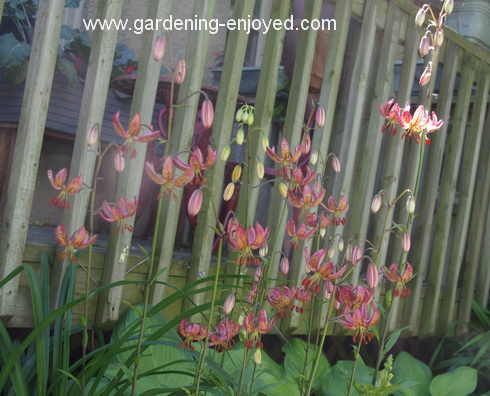
“Dallying” has not disappeared it's just been dallying. Life gets in the way of regular items like publishing my newsletter. The spring weather was too warm and then too cool and then the Assistant Gardener decided to mess with my planting schedule. St. Michael’s hospital is a wonderful institution but a week there is more than enough time to appreciate the skills of their cardiologists. About 3 weeks ago the A.G. had a new valve inserted into her heart, I wasn’t sure they could find a big enough one to fit that heart. Three days later when that recalcitrant valve didn’t like to function on its own, it was back to the O.R. to have a pacemaker fitted. Mustn’t climb stairs, drive, lift any weight nor lift her left arm above her shoulder. Her friends encouraged her to “milk it” as I interspersed gardening with nursemaiding and thus “Dallying” is a tad late but the A.G. is well on the mend and we will try to resume our semi-regular publishing schedule. This edition is a
little longer than most to try and catch you up to date in the garden.
These delightful little flowers are Martagon Lilies. I love them because they are always the first Lilies to bloom and they are happy in a reasonable amount of shade.
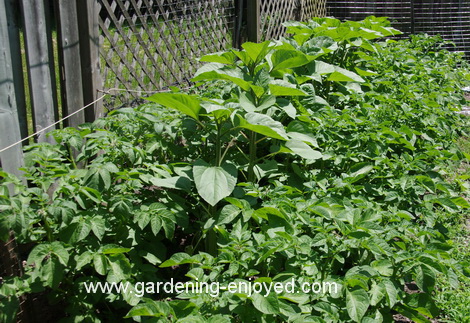
This appears to be a highly successful experiment. Those are Sunflowers planted between two rows of Potatoes. The idea was the sunflowers would grow fast and tall enough to tower over the Potato foliage and brighten up that section of the garden. The Potatoes are giving them a run for their money this year and if the size and speed of the foliage is any indication we should have a great crop and soon. The Sunflowers will be wonderful bonus.
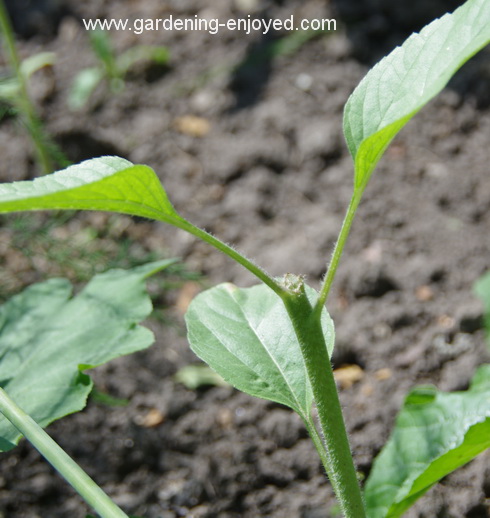
I’ve always had difficulty growing Sunflowers. Slugs love to eat the seedlings as they appear and they germinate rather sporadically outside. This year the Potatoes have played great defense. This truncated Sunflower is elsewhere in the garden and it appears that the old bunny that I say hello to most mornings has helped himself to its tasty top, probably upset that those nasty Potatoes kept him from those other delights.
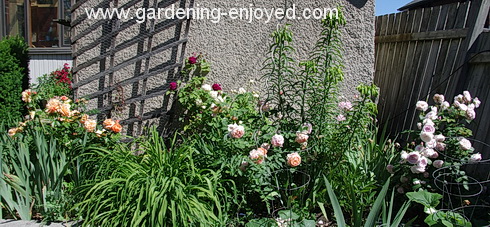
Several of my Roses are planted in a little raised bed behind the garage/garden shed. I prefer to think of them as a treasure waiting to be discovered rather then hiding behind the garage. They share this space with a few Daylilies, Narcissus, Lilies and a couple of Zucchini. Just one of my “well planned” gardens. Those Roses have all been spectacular this spring and at least two weeks early. The four David Austin’s along the wall were transplanted from another location in the garden and have happily survived the move and adjusted well to their new location. I had always wondered about moving an established Rose.
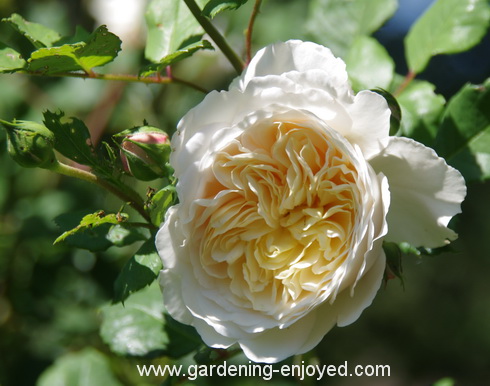
This is “Crocus” another of my David Austin Roses and she is magnificent this year. Austin’s web site says she will grow to 122 cm and she is currently close to double that and covered in these delightful blooms. I believe she does so well because she is planted right beside the waterfall and I suspect there is a bit of water leakage there keeping Crocus very happy. All the Roses were fertilized with Acti Sol’s Rose formula as they started to grow this spring and they seem to love it.
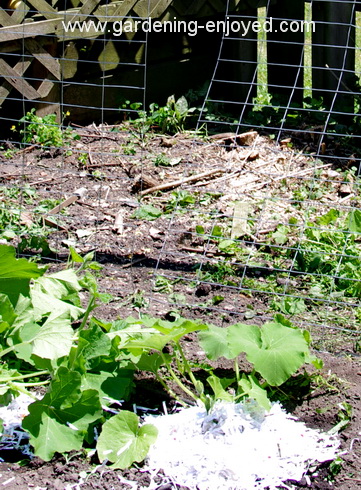
I used to have an orange fruited Lilac, which many of you may have seen in my Vertical Vegetables presentation. I had for many years guided my winter Squash vines up into the old Lilac bush in the corner of the vegetable garden. That Lilac’s time had expired and it made some trips to the fireplace and the compost. We still needed to grow those squash in that limited space so this 2" x 4" welded wire fence was suspended from the backyard fence and the Squash were advised of the desired direction to grow and they have quickly responded. Now hopefully the new structure will be sturdy enough to hold, if we get a bumper crop of Squash. The white around the base of the Squash is the shredded paper from the office. We pack it around the base of the stem in an attempt to stop the squash vine borer from laying her eggs into the base of those stems. Seems to work reasonably well and by next spring the paper mulch is just part of the soil.
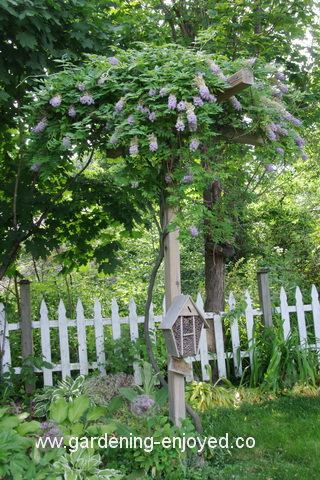
This Wisteria tree has only taken me about 17 years to perfect. Wisteria, as we know, is a large woody vine but having no structure to grow it on I decided, in 2007, to create a “tree.” That’s a 3 m 4x4 with a cross of 2.4 m 4x4's on top and some plastic clothesline joining them together to make an invisible platform for the Wisteria to lay its tendrils on, giving it a tree like appearance. Several years of pruning and guiding finally got it to the top with no branches on the way up. After installing the clothesline platform, pruning was continued for a few years to get all of the platform covered and this is a picture of all that effort. 17 years of pruning and training to get about two weeks of cascading bloom from the 2.4 m top of that “tree”. You don’t have to be a bit crazy to be a gardener but it helps.
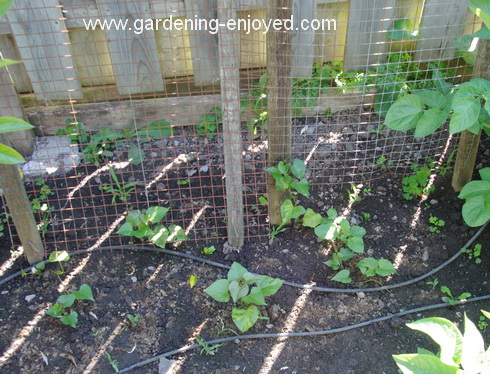
Many people have asked me, over the years, if it is possible to grow Sweet Potatoes in their home gardens. In my little part of the world, outside of Toronto ON, it is technically possible but not straight forward. I decided to try some this year. Sweet Potatoes, Ipomoea batatas are very temperature sensitive and will not tolerate any frost. Hot summers with adequate moisture can produce a reasonable crop. They are started from “slips” which are rooted cuttings of the vines that emerge from stored tubers. It is possible to produce your own but there are several commercial operations producing them. Those slips are planted well after the frost free date, mine were planted on 03 June and seem to be happily growing. The picture has some of them heading up a fence and some spreading across the soil. My first inclination with any vine type crop is to grow it up to maximize garden space but apparently they produce tubers when new roots emerge at each node as they
cover the ground. So, some up, some not and we’ll see what happens. The Vineland research institute has developed “Radiance” a short season cultivar well adapted to Canadian conditions. Mine are Beauregard a widely grown variety in the northern U.S.
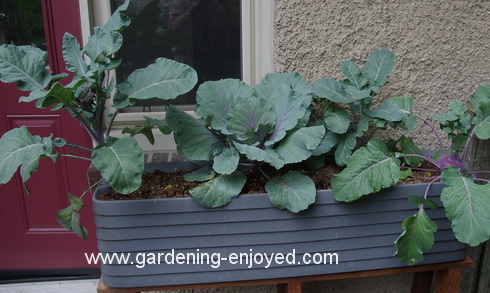 In the last issue of “Dallying” I showed you a new sub irrigation planter from Crescent Garden. I had planted it with a mix of early season vegetables and we have had mixed results. The picture has a great Kohl Rabi on the right end and a purple Broccoli on the left end. A Cabbage and a green Broccoli are developing in the middle. The Bok Choi immediately started to bolt but they were probably in their cell pacs too long. The real experiment, the seeds in the middle, never germinated. They were in the centre of the planter and near the surface and thus as far away as possible from the water that was wicking up. As the vegetables slowly find their way to the dinner table they are being replaced with flowers, mostly Begonia boliviensis and they seem to be growing well. The fine folks at Crescent Garden are happy to offer my readers a nice discount on any planter purchase using the code
SPRINGFOLLY.
In the last issue of “Dallying” I showed you a new sub irrigation planter from Crescent Garden. I had planted it with a mix of early season vegetables and we have had mixed results. The picture has a great Kohl Rabi on the right end and a purple Broccoli on the left end. A Cabbage and a green Broccoli are developing in the middle. The Bok Choi immediately started to bolt but they were probably in their cell pacs too long. The real experiment, the seeds in the middle, never germinated. They were in the centre of the planter and near the surface and thus as far away as possible from the water that was wicking up. As the vegetables slowly find their way to the dinner table they are being replaced with flowers, mostly Begonia boliviensis and they seem to be growing well. The fine folks at Crescent Garden are happy to offer my readers a nice discount on any planter purchase using the code
SPRINGFOLLY.
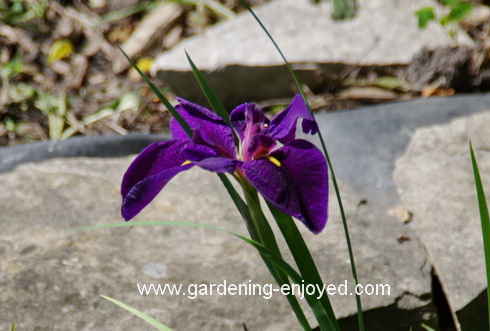 This is an unexpected treat. Several years ago I purchased a Louisiana Iris, because, I love Iris and it was different, and it would grow in my pond. It flowered that year and the year following and since then it has stayed alive and growing in the pond. Suddenly this year it is producing three blooms and making me very happy. Who knows why Mother Nature decided to treat me this year but I’m very thankful.
This is an unexpected treat. Several years ago I purchased a Louisiana Iris, because, I love Iris and it was different, and it would grow in my pond. It flowered that year and the year following and since then it has stayed alive and growing in the pond. Suddenly this year it is producing three blooms and making me very happy. Who knows why Mother Nature decided to treat me this year but I’m very thankful.
The roads are pleasant to drive on this time of year, as I am travelling around sharing my various presentations with hort. societies, garden clubs and corporate presentations for lunch and learns. I would love to come and visit your organization. Check out my web page at Gardening-enjoyed.com for more details on topics and availability.
If you have any gardening questions just “reply” to this emailed newsletter and I will attempt to answer them and then share them here if
they are of wide interest.
Carol Asks? some of my beds are very hard and lumpy. What's the best remedy? Peat moss ? Fertilizer? Sand?
Ken Answers!
Hard lumpy soil usually has a lot of clay in it. Add some sand and maybe a bit of peat. The sand will open it up and stop it from clumping.
Rachel Asks?My daughter was just gifted a black cherry tomato plant. I want to replant it in a larger container. I have been reading your newsletters but cannot seem to find the name brand of soil you recommended at the workshop. In any case, could you please recommend a good soil?
Ken Answers! Agro mix or Pro mix are two soils I use, both available at Vandermeers. They are both sterile, no weeds or diseases but they have minimal nutrient value and you must fertilize regularly. The trick to Tomatoes in a container is to keep them well watered and never let them dry out.
|

 In the last issue of “Dallying” I showed you a new sub irrigation planter from Crescent Garden. I had planted it with a mix of early season vegetables and we have had mixed results. The picture has a great Kohl Rabi on the right end and a purple Broccoli on the left end. A Cabbage and a green Broccoli are developing in the middle. The Bok Choi immediately started to bolt but they were probably in their cell pacs too long. The real experiment, the seeds in the middle, never germinated. They were in the centre of the planter and near the surface and thus as far away as possible from the water that was wicking up. As the vegetables slowly find their way to the dinner table they are being replaced with flowers, mostly Begonia boliviensis and they seem to be growing well. The fine folks at Crescent Garden are happy to offer my readers a nice discount on any planter purchase using the code
SPRINGFOLLY.
In the last issue of “Dallying” I showed you a new sub irrigation planter from Crescent Garden. I had planted it with a mix of early season vegetables and we have had mixed results. The picture has a great Kohl Rabi on the right end and a purple Broccoli on the left end. A Cabbage and a green Broccoli are developing in the middle. The Bok Choi immediately started to bolt but they were probably in their cell pacs too long. The real experiment, the seeds in the middle, never germinated. They were in the centre of the planter and near the surface and thus as far away as possible from the water that was wicking up. As the vegetables slowly find their way to the dinner table they are being replaced with flowers, mostly Begonia boliviensis and they seem to be growing well. The fine folks at Crescent Garden are happy to offer my readers a nice discount on any planter purchase using the code
SPRINGFOLLY. This is an unexpected treat. Several years ago I purchased a Louisiana Iris, because, I love Iris and it was different, and it would grow in my pond. It flowered that year and the year following and since then it has stayed alive and growing in the pond. Suddenly this year it is producing three blooms and making me very happy. Who knows why Mother Nature decided to treat me this year but I’m very thankful.
This is an unexpected treat. Several years ago I purchased a Louisiana Iris, because, I love Iris and it was different, and it would grow in my pond. It flowered that year and the year following and since then it has stayed alive and growing in the pond. Suddenly this year it is producing three blooms and making me very happy. Who knows why Mother Nature decided to treat me this year but I’m very thankful.






